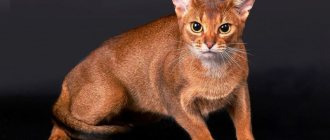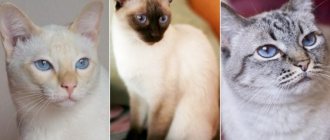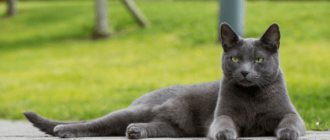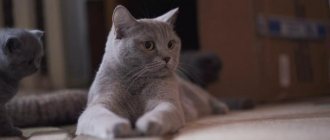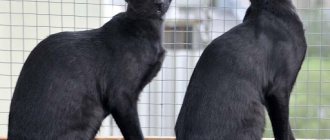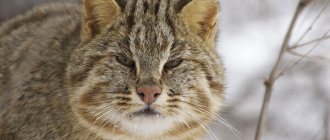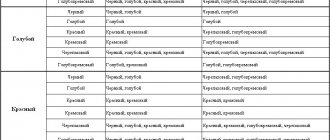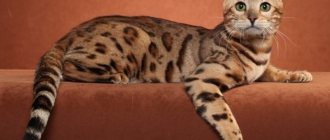History of the Abyssinian cat breed
Abyssinian cat
Abyssinian cats have become popular quite a long time ago, but researchers have not been able to find out the exact geographical region and time of origin of the breed. Several main versions have been formulated. The first said that the animals first came to Europe after the war between England and Abyssinia (Ethiopia) in 1868, where they originated from. As the main evidence, supporters of the theory used an English book from the second half of the 19th century with a lithograph of a cat named Zulu, which was acquired by Captain Barrett-Lenard after the end of the military campaign. Despite the external resemblance to modern representatives of the breed, there is no convincing evidence that the cat depicted was actually an Abyssinian.
Other researchers believed that the animals had Egyptian roots, since ancient figurines depicted similar pets. Perhaps they were the ones worshiped by one of the most mysterious civilizations in the world. At the same time, genetic analysis carried out by scientists showed that these cats were always closely related to animals that lived on the coast of the Indian Ocean. In any case, the ancient line of the breed was considered extinct. Modern Abyssinian cats first appeared at shows in Great Britain in 1871, finishing third among 170 other breeds.
A detailed description of these animals was made in 1882, the initial standard was formed by 1889, and official recognition with entry into the stud book awaited the breed only in 1896. In the early 1900s, the first representatives came to America, which ensured the survival of the breed in the future. The Second World War almost completely wiped out Abyssinian cats from the European continent - only about a dozen individuals remained in the UK. It was the American specimens that helped restore the population.
Due to the changes that cats managed to undergo in the USA, after the war it was necessary to recognize the existence of two branches that have survived to this day: American and European. These animals managed to gain worldwide fame, although they remained exotic in the CIS. According to the CFA, Abyssinian cats ranked second in popularity among short-haired breeds in the United States and Europe in 2012.
Interesting facts about the breed
1) The wild “lion” color of the Abyssinian breed is formed on the basis of yellow and black pigments. As the breed develops, the proportion of yellow increases all the time. 2) Breeders and nursery specialists note that Abyssinian litters often contain more boys. On average there are 3 cats per cat. 3) The first registered Abyssinians and Abyssinians bore the nicknames Aluminum and Salt. Today will anyone have the idea to name the chocolate brown cat Aluminum?!
Exhibitions: where and to whom to show yourself
Special exhibitions of the Abyssinian breed are not frequent, but usually, as part of all international cat exhibitions, competitions are held among Abyssinians. The breed is popular in many countries of the world, especially European, and is active in the Assolux Int exhibition system. Exhibition events are held regularly by nurseries that register their pupils under the CFA system and monitor the purity of the breed and individual subspecies. For example, the Moscow nursery “Super-Aby” mainly grows Red (Red, Sorrel) and Wild (Ruddy) colors.
Appearance of the Abyssinian cat
Abyssinian cat kitten
Abyssinian cats are strong and flexible and have a medium body size. Well-developed muscles and long legs allow animals to jump a distance of 6 times their own length. Males are larger than cats, but sexual demorphism is not as pronounced as in other breeds. Typically the weight is between 3-4.5 kg. Abyssinians have a chiseled silhouette, a harmonious physique, and move incredibly gracefully, which reminds them of miniature pumas. The American line has a more graceful and lighter build than the European line.
Head
Proportional, has a wedge-shaped shape without pronounced flat surfaces or points. The nape line gently merges with the neck. The nose is of medium length, straight, connected to the forehead by a smooth line. The chin is developed, firm, rounded. The muzzle is well defined and matches the soft contours of the head. Adult males may have prominent cheeks. Pinch, a pointed muzzle with a “foxy” expression, are considered unacceptable.
Eyes
The eyes of the Abyssinian cat are large, almond-shaped with a fairly wide set at a slight angle. An oriental or completely circular cut is not acceptable. Sparkling eyes can be any shade from amber to green. They have a black outline regardless of suit. If you have a silver color, a green eye tint is desirable. This zone always has a narrow light halo to match the undercoat. Dark lines in the corners of the eyes visually continue the outline of the upper eyelid.
Ears
Abyssinian cat face
Large, set wide, slightly tilted forward, which gives the cat an alert appearance. The ears are wide at the base, and narrowed and rounded towards the tips. The skin is covered with very short hair with a special bald spot in the center (the so-called “thumb print”). The inside of the ear may have woolen brushes.
Neck
The neck of the Abyssinian cat is graceful and quite long.
Body
Moderately elongated, flexible, with harmonious proportions. The body is medium in size, the muscles are developed, but not coarse. The chest is rounded, the back is slightly arched, but the hips should not be in a low position.
Legs and paws
The legs are strong, long and thin. Oval paws have small, well-pressed toes, which gives the impression that the cat is stretched out on tiptoe.
Abyssinian cat paws
Tail
The tail of the Abyssinian cat is thin, long, and narrows towards the end.
Wool
The cover is short and elastic, with a magnificent shine and characteristic ticking. The silky coat is thick and soft, with little undercoat, and lies close to the body. The cover is longer along the back, but this is almost imperceptible.
Color
Abyssinian blue cat
An important feature of the breed is its warm, rich color with an unusual iridescence and without a pattern. This is possible thanks to ticking, a phenomenon in which each hair has stripes of light and dark shades (from 2 to 5). The soles of the hind legs, back, and tip of the tail are slightly darker in color than the rest of the body, while the inner surfaces of the legs, belly and chest are lighter. The ticking is distributed fairly evenly; pronounced light areas are permissible only on the chin, lips, and around the nose. There are 4 generally accepted colors of the Abyssinian cat:
- wild (ruddy) – brown-orange shade;
- Sorel - redder cats with a reddish or chestnut tint;
- blue – grayish-blue color with a reddish tone;
- faun - creamy reddish color.
Also recognized are the “silver” variants of the listed colors, when the cat has a silver-white rather than a warm creamy undercoat tone. Lilac and chocolate shades are not considered the norm in all felinological systems.
Possible defects
Too narrow and elongated or excessively short round head, pronounced stripes on the legs, residual pattern on the body, pronounced cheeks. A significant disadvantage is a very light undercoat, insufficient ticking, round eyes, small ears. Animals with a flabby body, shortened legs, an insufficiently long tail, and without a thin edging on the eyelids will not be able to get high marks in the show.
Disqualifying faults
Siamese body type, too light areas on the fur, unbroken necklace.
What is known about Abyssinian cats
The list of the most ancient and noble breeds includes the Abyssinian cat, named after the old name of present-day Ethiopia. Smooth-haired Abyssinians are not called decorative - rather, they look like miniature wild cats with their even color and the flexibility of their elongated body. The breed was originally formed in England: the first Abyssinians were shown at the Crystal Palace in London at an exhibition in 1871. The pets, beloved by the British, were soon registered, and from 1896 they became known to the world as a separate breed. The Abyssinian Cat Club to promote clean breeding was founded in 1929 in Great Britain. Now, in addition to the European one, there is an American branch of the Abyssinian cat’s family tree. Individuals of the breed are often long-lived - their lifespan can approach 20 years. How long an Abyssinian lives depends on both the care and the subspecies of the breed.
Read more about the life expectancy of Abyssinians
Where does the sun cat actually come from?
African Abyssinia and Egypt store many recognizable images of cats - small, graceful, with expressively large erect ears. These are found in paintings dating back to the 14th century BC. e. - for example, in the “Book of the Dead”, opened in the tomb of the nobleman Nebamon. Sculptures and such colorful “talking” epithets as “lapis lazuli” and “sunny cat” are also known from ancient sources.
Modern Abyssinian cats are remarkably similar to images from Egyptian frescoes. That is why there is an opinion that these are the descendants of temple sacred animals, the favorites of the pharaohs. A beautiful “royal” legend. But in fact, scientists are sure that the breed was developed much later - in the second half of the 19th century. But the ancestor is considered to be an African cat, actually brought from Ethiopia (then Abyssinia) to England. At first, his descendants were called in Europe “zula” after the name of this cat or “rabbit breed” based on the type and color of their coat.
International breed standards and classifiers
Although the exact date of appearance of the breed has not been established, according to world standards adopted by the Cat Fanciers Association, the appearance of an Abyssinian cat must meet the following parameters:
- The head is wedge-shaped (pointed muzzle), proportional to the body - small, but on a rather long neck.
- The ears are high and wide, erect, deep, and set wide apart. At their ends the color is darker, sometimes there are tassels, giving the Abyssinian a resemblance to lynxes
- The body is elongated, muscular, graceful - healthy individuals are not fat, their weight should be no more than 6 kg.
- The legs are long and strong with oval and small, even miniature paws, which makes the cat seem to move on tiptoes. The height of a male can reach 32 cm, a female – 28.
- The tail is long and thick at the base. It tapers smoothly towards the tip and has a darker color and shorter coat.
- The eyes are wide-open, almond-shaped, with expressive dark outlines and light outlines called “glasses.”
From the description it is obvious: the Abyssinian cat is harmoniously built and very graceful, like one of its ancestors - the jungle cat.
Colors and coat of a purebred Abyssinian cat
Currently, the Cat Fanciers Association (CFA) officially recognizes four of the main colors of Abyssinians: - ruddy, or “wild” - orange-brown;
- red, or “sorrel”, red, more precisely - chocolate brown, fawn, “bay”;
- fawn, or “fawn” - beige or pinkish-beige;
- blue, not quite blue, but gray-blue shades.
All shades of color and coat characteristics of each type of Abyssinian are special and are discussed in a separate article. But a mandatory sign of the breed is the dark tip of each hair.
Read more about Abyssinian colors
Photo of an Abyssinian cat
Wild color
The most common and first recognized color is wild. It was registered in 1963.
The ticking of these kittens varies from dark brown to ocher. Inside, the paws and belly are painted a bright orange tint. These pets have absolutely no pattern on their fur. If the pet has a bright and attractive color, then there will be no price for it.
Red-brown paws, a dark brown streak along the entire ridge is present in the wild color. The tail also has a dark brown tint that ends in black. The nose is outlined in dark brown, and it itself has a red, even brick color. The pads come in two types: dark brown or black.
The most common eye color for wild Abyssinians is golden. However, it is rare that there are kittens with hazel or green eyes.
In kittens, after two months of their life, the color of their eyes begins to change, so it is impossible to judge exactly what it will be. This will become clear closer to the year the cat has lived.
For a long time, this color was the only one among Abyssinian cats. However, in 1963 the situation changed, but wild began to be called classic. It is characterized by the following symptoms:
- The undercoat is brown, orange (warm shades), on the belly and the inside of the legs there is a dark apricot color.
- The awn is black at the tips.
- Paws - pads black or dark brown.
- The nose and nose are brick red in the middle, outlined with a black or dark red line.
The color in the pedigree is written in Latin letters - Ruddy, designation in the form of a code - Aby (n).
Character of Abyssinian cats
Abyssinian cats are very active animals that strive to explore the world around them. Their playfulness continues throughout their lives. Despite their predatory wild appearance, these cats are balanced, intelligent and intelligent, and very affectionate towards family members. Abyssinians do not show aggression, they usually do not extend their claws during games, and they are patient with children. Cats constantly patrol their territory in search of interesting activities, they like to climb as high as possible to observe - provide them with this opportunity.
Oh, box
Representatives of the breed are distinguished by neatness and cleanliness, they respect the rules established by the owner: they will not tear up furniture (especially if there is a scratching post), ride on curtains or knock down flower pots. But it is better to remove sharp, especially fragile objects, close windows on the top floors or protect them with a special net - in the heat of play, a cat can harm itself or make a mess.
Abyssinian cats have an independent character and self-esteem, so they will not tolerate disrespectful treatment and will not constantly sit on your hands. In character, they are a bit like dogs: they are loyal, play with pleasure, bringing back objects thrown by their owner. Abyssinian cats are good parents, so they do not need help in giving birth, feeding or raising their offspring. Smart, elegant pets require human attention and contact with the owner. Without this, the animal may become depressed and get sick.
Origin story
Scientists have established that the first images of Abyssinian cats are depicted on tablets in the tombs of Egyptian pharaohs. They belonged only to them and their relatives - ordinary Egyptians did not have the right to keep these graceful and majestic animals. As the name suggests, the birthplace of the breed is ancient Abyssinia, which is now called Ethiopia. Thus, the history of the breed lasts exactly as long as our civilization exists.
From Egypt in 1907, two representatives of the breed were brought to America. The Second World War almost interrupted the breeding work, but the unique Abyssinians were preserved. Unlike adults, small kittens are clumsy and acquire a royal gait only with age.
Care and maintenance
Abyssinians are unpretentious, but their health requires attention so that the pet gets sick less often and lives a long time.
Getting to know your new home
Abyssinian
When bringing a kitten into your home, remember that he is very shy, so you should introduce him to the outside world, family members, and pets slowly. Pay attention to him, but do not overload him with games, so that the baby has time to get stronger and get used to the new environment. The animal explores the house on its own; it is worth providing it with a separate comfortable bed and scratching post.
Hygiene
Abyssinian cats are easily accustomed to a tray with natural filler or to the toilet. If you accustom your pet to water procedures from a tender age, in the future there will be no problems with bathing at all - most of the representatives of the breed love to swim. It is advisable not to wash the animal too often; once during the molting period is enough. In this case, use a special shampoo for short-haired cats (without conditioner). After bathing, dry your pet thoroughly and let it dry.
It is worth brushing your Abyssinian cat's teeth periodically, as she is prone to plaque and tartar formation. Particular attention should be paid to keeping the ears clean.
Wool
The short, dense coat requires virtually no grooming. It is enough to go through the wool with a special brush once a week. Molting goes quickly and does not cause any particular inconvenience.
Nutrition
Abyssinians will willingly eat special food or food you prepare. In the latter case, you should consult a veterinarian who will prescribe additional vitamins and nutritional supplements. Pay a little attention to the diet so as not to overfeed the animal. Up to one year of age, kitten food should be provided three times a day. It is advisable to use the same brands that the breeder fed the babies. Upon reaching one year of age, you can switch to products for adult cats, giving a slightly larger portion twice a day.
It is advisable to cook meat and fish; give raw foods only when you are sure of their quality and after cutting them into small pieces. Many Abyssinian cats enjoy eating fruits and vegetables - over time, you yourself will understand which ones your pet prefers.
Kus
My man loves me
How to raise and train Abyssinians
More than other animals, when raising and training a cat, the use of a human reward system is suitable. Affection is also a positive reinforcement, but a treat will work better.
A person who is afraid of or hostile to a cat will never be able to accustom the animal to even the most basic things. The tidbits won't help here: you can't bribe this animal, but you need to win affection and trust.
Education, like with people, begins at birth, and training from the moment when the cub looks at the world meaningfully. Learning techniques and tricks always begins with observing personal qualities and inclinations. Having noticed, for example, that the cat often carries objects in its teeth, you can give the command “Fetch” and encourage it at this time. Having repeated the procedure many times, the owner’s patience is the main trump card here! – you can achieve the execution of the commands “show stance”, “jump”. The formula “through natural desires and inclinations to obedience” works well in the case of cats, but getting them to do something that does not bring pleasure is almost impossible.
Health and diseases of the Abyssinian cat
In general, Abyssinian cats are healthy, cheerful animals. When illnesses do occur, they are often associated with poor diet or genetic problems. Thus, in some lines, retinal retinopathy develops, due to which the Abyssinian cat becomes completely blind by the age of 5. This disease can be detected in a kitten in advance and responsible breeders weed out such individuals. Rarely, anemia can develop with age due to a lack of pyruvate kinase. Infrequently, renal amyloidosis occurs, leading to serious consequences for the health of the pet. The breed is prone to hip dysplasia and patella dislocations. You should brush your teeth regularly and make sure there is no licking. Bring your Abyssinian cat to the veterinarian periodically for a preventive appointment and do not self-medicate. With proper care, the animal will live 15-20 years.
Mother cat with kitten
Metis: how they differ from purebred Abyssinians
Mixed breeds of the Abyssinian breed differ strikingly from purebred individuals, which is due to the peculiarities of the genetic inheritance of colors. An Abyssinian crossed with someone will either have dirty gray or other unusual shades of fur and undercoat, or stripes will appear on the neck and paws. Such visible exterior features as a white medallion or a white belly are absolutely excluded in the Abyssinian breed, since they do not have the white spotting gene. The base breed also cannot have white "slippers".
Most often, Abyssinians are crossed with a similar breed - the Somali. The resulting individuals - Abivars - are now registered by most felinological associations as Abyssinians, but the American CFA classifies them as Somali shorthairs.
Mestizos, outwardly almost no different from purebred Abyssinians, carry the gene for long hair. As a result, fluffy and even shaggy kittens can be born from mating in the future. There are such types of mestizos as a caracal hybrid, a cross with a Bengal cat.
It is not difficult even for amateurs in breeding cats to compare and distinguish a mestizo from a pure breed. Only those who are professionally engaged in reproduction and strictly monitor compliance with all the characteristics of a particular subspecies without impurities should look at differences as shortcomings.
How to choose a kitten
Contact only reputable breeders or large nurseries. You should adopt a kitten no earlier than three months of age. By this time, the seller manages to give the Abyssinian several vaccinations, accustom him to the tray, and transfer him to independent feeding. In addition, the baby will become psychologically stronger and will be ready to move to a new home. By taking your pet at an earlier age, you seriously risk its physical and emotional health.
Make sure that the breeder issues all medical certificates for the animal and a pedigree that will record the absence of inbreeding. The kitten should be playful, sociable, and not too timid. Shiny fur, a confident gait, the absence of palpable hernias on the abdomen, or discharge from the eyes or ears are the main signs of a healthy Abyssinian cat.
Advantages and disadvantages
Experts highlight the following advantages of the breed:
- sophistication in every movement;
- smart;
- active and inquisitive;
- friendly with children and other animals;
- rare coat color, different from its relatives.
The disadvantages of Abyssinians include:
- naturally cautious;
- do not like to sit on the owner’s lap, preferring elevated places in the apartment;
- love to play mischief;
- They cannot be without their owner for a long time.
Photos of Abyssinian cat kittens
Blue
This is a very rare color, as most breeders work with the first two types. There are practically no blue Abyssinians in the USA, and it was from there that cats were imported to continental Europe when there were no more than a dozen purebred animals left.
For blue cats:
- The coat is gray-blue and with a metallic tint, on the belly and the inside of the limbs it is pinkish cream.;
- Awn - tips - dark blue, roots with undercoat - creamy pink.
- Ticking - bluish-gray zones alternate with beige ones.
- The nose is dusty pink with a bluish-gray outline.
- Paw pads are pink with a blue tint.
- Blue cats of this breed are spectacular; their fur shimmers due to the combination of pastel shades with gray in several variations. This is a dilute (lightened) color. In pedigrees they write Blue and the code is Aby (a).
Blue coat color is present in almost all cat breeds. If a cat has had black relatives for generations, then sooner or later subsequent offspring will acquire a blue color. The blue color of Abyssinian cats was officially recognized in 1984.
Unlike the fur of other colors of this breed, the blue color has the most visible contrast and its own characteristics.
- Cats should not have bleached undercoat.
- Along the spine there is a pronounced blue stripe, in contrast to the whole body.
- On the belly, chest, chin and paws the undercoat has a lighter shade. It can be apricot, beige, light brown or cream.
- The fur on the back, head and tail is grey-blue.
- The nose may be brown or blue-gray. Eye color ranges from copper to green; there are also cats with golden or hazel eyes.
In 1984, it was officially recognized that blue color exists in Abyssinian cats. Ticking alternates colors: blue-light gray to deep gray-blue. The undercoat of these animals is light pink-beige or apricot, as is the belly and paws on the inside.
The stripe on the back of the Abyssinian cat is a deep color, dark blue. The Abyssinian nose is gray-blue, but if it is red-brown, then it has a gray-blue outline. The cats' pads are bright purple, and the hairs between them have a blue tint.
Abyssinians have eyes of bright colors, such as hazel, gold, green or copper.
Purchase
To buy a real Abyssinian kitten, it is better to contact a nursery. An adult animal, due to its attachment to its owner, is less tamed. At two months of age, the kitten is ready to separate from its mother, but breeders prefer to give them away at the age of 12-16 weeks, when they best adapt to their new family.
When choosing, you should pay attention to its external characteristics: how healthy the skin, coat, and mucous membranes are. There should be no damage, scratches, scabs, or rashes anywhere. A healthy animal shows activity and curiosity, the stomach is not bloated or sunken.
The cost will depend on the following factors:
- Class – “show” (exhibition version), “breeding” (for producing offspring), “pet” (pet).
- Purity of parental lines.
- Reputation of the nursery.
- Color. For the rarest blue the price will be higher.
The average price, depending on all components, varies from fifteen to eighty thousand rubles.
Nutrition
Graceful Abyssinians can eat both industrial food and natural food. In the second case, the diet must necessarily consist of:
- boiled lean meat (chicken, turkey, lamb, rabbit);
- low-fat sea fish (but not more than 2 times a week);
- boiled vegetables (broccoli, carrots, zucchini) - they can be chopped with a knife or pureed in a blender;
- dairy products - beware of regular cow's milk, it is better to use fermented milk products (kefir, cottage cheese, yogurt);
- boiled chicken egg (1-2 times a week);
- vegetable oil (linseed or olive) – it is better to add it little by little to the dish in order to saturate the pet’s body with fats.
If you plan to create a menu for your Abyssinian kitten from natural food, be sure to buy a vitamin-mineral complex so that the fluffy one receives all the necessary microelements.
It is much easier to feed an animal with high-quality industrial feed. Both wet and dry types can be used. It is better to stick to super-premium or holistic food. This way you can be sure that the composition includes high-quality meat and healthy ingredients.
Make sure your Abyssinian always has a bowl of clean drinking water.
